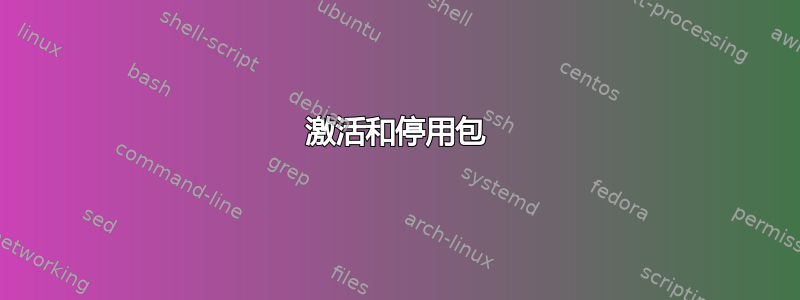
在我的代码的某个时刻,我想激活一个包(在本例中yhmath),然后很快将其停用。我该怎么做?谢谢(你需要我的代码吗?我不这么认为,是吗?
第一次编辑:我问你这个问题是因为我正在使用yhmath和amsmath包,并且在我的代码的某个时刻我使用这个奇怪的符号\left\{...\right}:
为什么??
第二次编辑:读评论有人要求我写 tex 代码:
\PassOptionsToPackage{svgnames, x11names} {xcolor}
\documentclass{article}
\usepackage[italian]{babel}
\usepackage[utf8]{inputenc}
\usepackage[a4paper,top=3cm,bottom=3cm,left=3.5cm,right=3.5cm]{geometry}
\usepackage{xcolor}
\usepackage{imakeidx}
\usepackage[tight, italian]{minitoc}
\usepackage{stix}
\usepackage{tikz}
\usetikzlibrary{tikzmark,calc}
\usepackage{amsmath,mathtools}
\usepackage[full]{yhmath}
\usepackage[bb=ams]{mathalpha}
\usepackage{eqexpl}
\usepackage[most]{tcolorbox}
\tcbuselibrary{breakable,theorems,skins}
\usepackage{hyperref}
\newif{\ifTOC}
\newcommand{\mytikzmark}[1]{\ifTOC\tikzmark{#1}\fi}
\newcommand{\Tonde}[1]{\left(#1\right)}
\newcommand{\Quadre}[1]{\left[]#1\right]}
\newcommand{\Graffe}[1]{\left\{#1\right\}}
\newcommand{\Angolare}[1]{\left\langle#1\right\rangle}
\newcommand{\String}[1]{\mbox{string}\Tonde{#1}}
\newcommand{\I}{\mathcal{I}}
\newcommand{\N}{\mathbb N}
\newcommand{\Nquattro}{\N^{\times4}}
\renewcommand{\S}{\mathbb S}
\newcommand{\Ldots}{,\ldots,}
\DeclarePairedDelimiter\autoTonde{(}{)}
\renewcommand{\Tonde}[1]{\autoTonde*{#1}}
\DeclarePairedDelimiter\autoQuadre{[}{]}
\renewcommand{\Quadre}[1]{\autoQuadre*{#1}}
\DeclarePairedDelimiter\autoGraffe{\{}{\}}
\renewcommand{\Graffe}[1]{\autoGraffe*{#1}}
\DeclarePairedDelimiter\autoAngolare{\langle}{\rangle}
\renewcommand{\Angolare}[1]{\autoAngolare*{#1}}
\begin{document}
\title{\color{red}{\Huge{\textbf{Nuovo Pacchetto --- Modello Matematico
}}}}
\author{\color{blue}{\Huge{\textbf{MATTIA ONOFRI}}}}
\date{17 Agosto 2021 --- xx Mese Anno}
%\frontmatter
\maketitle
\begin{abstract}
\end{abstract}
\tableofcontents
%\dominitoc\begin{tcolorbox}[breakable,enhanced,title=\Huge{INDICE GENERALE},colframe=orange,colback=Silver!75,colbacktitle=Gold1,fonttitle=\bfseries,coltitle=red,attach boxed title to top center={yshift=-0.25mm-\tcboxedtitleheight/2,yshifttext=2mm-\tcboxedtitleheight/2},boxed title style={boxrule=0.5mm, frame code={ \path[tcb fill frame]([xshift=-4mm]frame.west) -- (frame.north west) -- (frame.north east) -- ([xshift=4mm]frame.east) -- (frame.south east) -- (frame.south west) -- cycle; },interior code={ \path[tcb fill interior] ([xshift=-2mm]interior.west) -- (interior.north west) -- (interior.north east) -- ([xshift=2mm]interior.east) -- (interior.south east) -- (interior.south west) -- cycle;} }] \csname @starttoc\endcsname{toc} \end{tcolorbox}
\newpage
%\mainmatter
\Large
\section{\texttt{NiceIndex}--\texttt{package}}
Dato un generico \textbackslash\texttt{tableofcontents} dotato di un numero $i\in\I\equiv \bigl\{0,1\Ldots n\bigr\}\subset\N$ di capitoli, ciascuno dei quali ha un numero $i_j\in\I$ di sezioni, le quali hanno un numero $i_{j_k}\in\I$ di sottosezioni che hanno un numero $i_{j _{k_h}}\in\I$ di sotto--sottosezioni $\Tonde{i_{j_k},i_{j_{k_h}}\ne0}$, sia
\begin{equation}
f\Tonde{i,j,k,h}:\Nquattro \longrightarrow\S:v=\Tonde{i,j,k,h} \longmapsto\mbox{stringa}
\end{equation}
una funzione così definita: $f\Tonde{i,j,k,h}:=\overline{\String{i_{j_{k_h}}}},\forall i_j\in\I_{\I}$, e
\begin{equation}
\overline{\String{i_{j_{k_h}}}}:=\max_{i_{j_{k_h}}}\left[\String{i_j},\String{i_{j_k}},\String{i_{j_{k_h}}}\right]
\end{equation}
\flushleft$\!\!\begin{array}{cll}
\text{di cui}&\String{i_j}&=\Angolare{\text{lunghezza della sezione }i_j}\\
&\String{i_{j_k}}&=\Angolare{\text{lunghezza della sotto--sezione }i_{j_k}}\\
&\String{i_{j_{k_h}}}&=\Angolare{\text{lunghezza della sotto--sotto--sezione }i_{j_{k_h}}}.
\end{array}$
Ora si definisca una nuova funzione
\begin{equation}\label{gijkh}
g\Tonde{i,j,k,h}:=\Angolare{\mbox{convert in points}}\Tonde{f}
\end{equation}
Inoltre prendere una lunghezza
\begin{equation}
L \Tonde{i,j,k,h}=\Angolare{\begin{array}{c}\mbox{altezza}\bigl(=\mbox{lunghezza in verticale}\bigr)\mbox{ del blocco}\\\mbox{formato da }i_j,\mbox{ eventuali }i_{j_k}\mbox{ ed eventuali }i_{j_{k_h}}
\end{array}}\label{Lijkh}
\end{equation}
Convertire anche la (\ref{Lijkh}) in punti, con la (\ref{Cijkh})
\begin{equation}\label{Cijkh}
c\Tonde{i,j,k,h}:=\Angolare{\mbox{convert in points}}\Tonde{L}
\end{equation}
Costruire con \textbf{TikZ}, infine, un rettangolo così definito:
\begin{equation}
\backslash\texttt{rectangleTOCijkh}\Bigl\{\mbox{base}=(\ref{gijkh}), \mbox{altezza}=(\ref{Cijkh})\Bigr\}
\end{equation}
\textit{Suggerimento}: Si usi la seguente stringa in blu:\\
\textcolor{blue}{\textbackslash\texttt{newcommand\{\textbackslash{mytikzmark}\}[1]\{\textbackslash{ifTOC}\textbackslash{tikzmark}\{\#1\}\textbackslash fi\}}}.
\end{document}
为什么yhmath会产生这么多问题呢?




